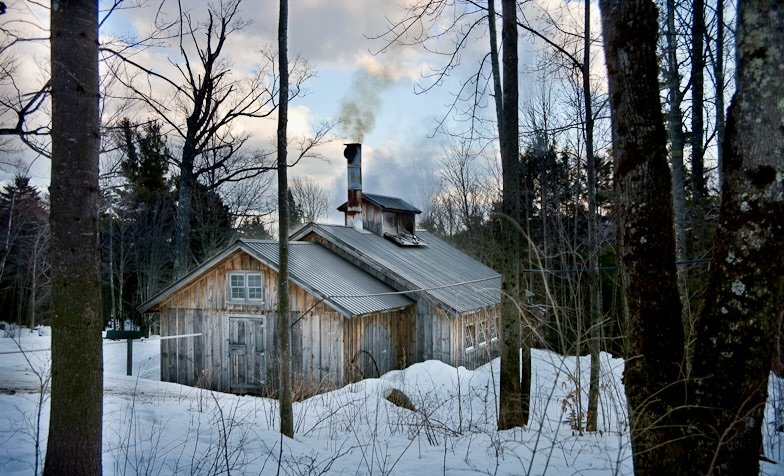
Photo credit: Greg Premru
Sweet and Simple
The New England sugarhouse has the same organic, natural qualities as the stuff that gets made inside it. Making maple syrup was and is tough work, and there’s never been time for or interest in trim moldings and soffit details. Simple and unaffected, sugarhouse design comes from farmers whose architectural skills were rooted in the field rather than the academy and whose aim was to get a job done with a minimum of fuss and waste.
Before there were buildings devoted to its production, however, there was maple sugar. Early Native Americans knew about the maple tree’s slightly sweet sap and learned how to concentrate it through boiling, or by freezing it and removing the ice. The colonists brought their iron pots, and the resulting syrups and sugars became an important alternative to expensive imported cane sugar. Later on, maple products took on an anti-slavery aspect: as the 1803 Farmers’ Almanac exhorted, “Make your own sugar and send not to the Indies for it. Feast not on the toil, pain and misery of the wretched.”
Over time, maple sap became a New England commercial crop, husbanded and harvested in the forest. Whether the locals call it a sugar wood or a sugar bush, a grove of maples is where things get very busy at the earliest stirrings of a northern spring. Warm sunny days alternate with freezing night to draw sap--it’s about 98% water and 2% sugar, minerals, and even vitamins--up through a tree’s circulatory system, and into a sugarmaker¹s taps. Beyond the science, though, is the magic of the awakening woods. “There is something about them that pulls like a magnet,” wrote Muriel Follett in a 1941 memoir of sugaring in Vermont. "A sap run is the sweet good-bye of winter,” the 19th-century naturalist John Burroughs observed. “It is the fruit of the equal marriage of the sun and the frosts."
In sun or frost, the task remains the same: the sap needs to be boiled down, and the syrup has to be gotten to market. In the old days of collection by bucket, it made sense to haul the least amount of liquid the farthest distance, so the business of reducing sap to syrup, at a ratio of 40:1, took place where the sap was, deep in the woods. That’s where the original sugarhouses were built, their remoteness necessitating the kind of “toggled-up and patched-together” construction seventh-generation Vermonter and sugar maker Burr Morse remembers.
“Those old farmers couldn’t afford or justify dragging a carpenter into the woods,” he points out. “They just built them as they could.” What they needed was shelter for their evaporator—an arch of bricks forming a firebox under a set of shallow metal pans. What they built were simple post-and-beam rectangles, with steep roofs to shed snow, rough vertical siding, and an open cupola to let the resulting copious steam out. (Morse points to this fact of sugar making as another reason not to get too fancy with the construction: “Steam is no friend of finish carpentry.”)
The ideal spot was on a hillside, so that a sap tank could be put above the building, with gravity feeding the evaporator inside. An open porch would hold the firewood, a bunk would hold the exhausted farmer. As one account had it, “You will sleep soundly after gathering 30 barrels of sap.” But there was a rough romance in the work too. When the sap was running strong, boils continued through the night, under crystal stars and “amid the silent trees, “ as Burroughs wrote. “And,” recalls Follett, “there is always the crackling sound of the wood fire, the soft hissing of the boiling sap and the mingling smells of the smoke, the sap and the damp earth outside.”
Early on, sugarhouses sat on flat stones and had wood shingles on their roofs; later came concrete footings and floor slabs, as well as corrugated metal roofing to prevent sparks from burning the whole affair down. The framing and siding were usually hemlock, “big-around trees that are easy to make lumber from,” says Morse. “It’s not a pretty wood, but it gets the job done.” No paints or stains this far out in the woods—the structures were left to weather. And so they did, turning a dark brown and lasting as long as a hundred years or more. And when a new one needed building, Morse says, “You’d build it like the old ones.”
Times and technology change, of course, and the advent of oil-fired evaporators and plastic sap lines lead many makers to reverse the old calculations. Now the sap is brought down from the sugar bush and close to oil delivery trucks and syrup customers’ vehicles. Reverse osmosis is also a fact of much modern sugar making: forcing the sap through specialized membranes strips out 75% of the water and makes the boil-down that much faster.
The combination of “r.o.” and oil is too much for guys like Morse and Stuart Osha, a sugar maker in Randolph, Vermont. Both swear something important in the flavor gets lost that way. Even though they get to sleep in their own beds, they and other traditionalists still try to capture that old-time deep-woods essence, making their syrup in small batches over wood fires--though even they put their sugarhouses down by the roadside, complete with parking lots.
Osha built a new sugarhouse a few years ago. When pressed to describe its architecture, he says, “Oh, you know, just like ones you see everywhere.” And so goes the organic, natural non-evolution of the New England sugarhouse.